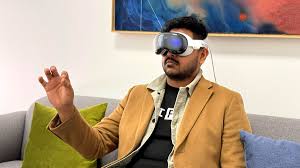Apple Vision: The Future of Augmented Reality and Beyond

reality (AR), virtual reality (VR), and artificial intelligence (AI) to create an experience that blurs the lines between the digital and physical worlds. This cutting-edge technology has the potential to reshape industries ranging from entertainment to healthcare, education to gaming, and much more.
In this article, we will explore Apple Vision’s evolution, its groundbreaking features, its potential impact on various sectors, and what makes it a game-changer in the tech world.
What is Apple Vision?
Apple Vision refers to Apple’s new range of augmented and virtual reality technologies, including both hardware and software innovations. This initiative builds upon years of research and development in augmented reality and virtual reality by Apple. Apple Vision isn’t just a single device but rather a suite of interconnected hardware and software solutions that allow for immersive digital experiences.
In June 2023, Apple unveiled its first major hardware product designed specifically for AR and VR experiences: the Apple Vision Pro. This device represents Apple’s vision of the future of computing, offering an immersive AR experience while also allowing users to access traditional computing tasks. The Apple Vision Pro has been touted as the most advanced spatial computer available, combining cutting-edge displays, sensors, and processors to create an entirely new experience.
A Look at Apple Vision Pro
The Apple Vision Pro is a mixed-reality headset designed to deliver immersive AR and VR experiences in an intuitive, user-friendly way. The device’s unique design features include:
- High-Resolution Displays: The Apple Vision Pro comes with ultra-high-definition displays that offer lifelike visuals. Each eye receives a custom display with over 23 million pixels, providing stunning clarity that far exceeds most VR and AR devices on the market.
- Spatial Audio: The device integrates spatial audio, offering an immersive 3D sound experience that adapts to your head movements, enhancing the realism of the experience.
- Eye and Hand Tracking: Apple Vision Pro utilizes advanced eye-tracking and hand gesture controls, allowing users to navigate the interface intuitively without the need for a physical controller. This technology enables users to control apps and interact with digital objects using their eyes and hand gestures, offering a seamless user experience.
- Mixed-Reality Capabilities: One of the standout features of the Apple Vision Pro is its ability to seamlessly blend the physical world with digital content. Users can interact with digital overlays while still being aware of their real-world surroundings, making it ideal for various applications, including gaming, communication, and productivity.
- Computational Power: The device is powered by Apple’s custom chips, including the M2 chip and the newly developed R1 chip, designed to handle the immense amount of data processing required for real-time AR/VR experiences.
- Modular Design: The Vision Pro has a modular design that can be customized with different lens options for people with vision impairments. This makes it more accessible to a wider audience and ensures comfort during extended use.
The Software Behind Apple Vision
While the hardware of Apple Vision is impressive on its own, the software that powers it is just as groundbreaking. Apple has invested heavily in the development of an entire ecosystem to support its mixed-reality devices, with the Vision Pro as the flagship product.
- visionOS: This is the operating system designed specifically for the Vision Pro. Built on macOS, visionOS is optimized for AR and VR applications, offering a spatial interface that adapts to your environment. The OS supports multi-tasking, allowing users to run multiple apps in a shared space, making it possible to use the device both for entertainment and work.
- Spatial Apps: Apple has introduced a variety of spatial applications designed for Vision Pro, such as interactive 3D content creation tools, immersive video conferencing platforms, and productivity apps that allow users to interact with digital documents and presentations in a completely new way. Apple has also partnered with major software developers to ensure that popular apps, including Microsoft Office and Adobe Creative Cloud, are optimized for AR/VR use.
- ARKit 5: Apple’s ARKit has been central to the company’s push into augmented reality, and with ARKit 5, the company has brought new features to enhance the AR experience on Vision Pro. The platform allows developers to create more immersive and interactive experiences by leveraging the device’s advanced sensors, including the ability to map your environment in real time and place virtual objects in it.
- Siri Integration: As with many other Apple devices, Vision Pro integrates with Siri, Apple’s voice assistant. This allows users to control the device using voice commands, making navigation even more intuitive.
Applications of Apple Vision
The potential applications of Apple Vision are vast, as the technology merges the digital world with the physical one in ways that were previously unimaginable. Some of the key areas where Apple Vision could make a major impact include:
1. Entertainment and Gaming
Apple Vision is poised to redefine the entertainment and gaming industries by offering users immersive, interactive experiences. The high-resolution displays and spatial audio deliver lifelike visuals and sound, creating a more engaging gaming environment. Apple has already partnered with game developers to create AR/VR versions of popular games, while also working on creating original content specifically for the Vision Pro.
Imagine watching a movie where the characters appear in your living room or playing a game where the world around you becomes the game world. The integration of AR and VR technology opens the door to entirely new forms of interactive storytelling.
2. Education
The educational potential of Apple Vision is also immense. With its ability to create immersive, interactive environments, the device can transport students to historical sites, outer space, or even the human bloodstream for biology lessons. AR and VR can enhance learning by allowing students to engage with 3D models, participate in virtual field trips, or experiment in simulated environments.
Teachers can also use the device for real-time collaboration with students, whether that’s conducting group activities in virtual environments or discussing projects in mixed-reality spaces.
3. Healthcare
In healthcare, Apple Vision could revolutionize patient care and medical training. For example, medical professionals could use the technology to visualize patient data in 3D, making it easier to analyze complex medical conditions. Surgeons could train in a virtual environment before performing delicate operations, and doctors could use AR overlays to assist with procedures.
Apple Vision’s ability to provide real-time, immersive feedback could also improve rehabilitation for patients recovering from surgery or injury by offering guided exercises and monitoring progress.
4. Productivity and Workspaces
Apple Vision could change the way we work by providing a virtual office space where you can have multiple virtual monitors, interact with colleagues in immersive meetings, or collaborate on projects in a 3D space. The Vision Pro supports multi-tasking, meaning that users can access several applications simultaneously, whether it’s for coding, editing videos, or managing large data sets.
For creative professionals, Apple Vision offers a new dimension for content creation. Designers, animators, and architects can interact with 3D models in ways that were previously only possible with physical prototypes.
5. Retail and Shopping
Apple Vision could transform the retail experience by allowing consumers to interact with virtual representations of products before purchasing. Virtual fitting rooms could let shoppers try on clothes or accessories without ever leaving their homes, while furniture retailers could let customers see how products would look in their own living spaces.
AR could also be used in stores to provide additional product information, promotions, or even virtual sales assistants, enhancing the in-store shopping experience.
The Challenges of Apple Vision
While Apple Vision presents a bright future for technology, it also comes with its own set of challenges:
- Cost: At a starting price of $3,499 for the Vision Pro, the device is positioned as a premium product. The high cost could limit its adoption to tech enthusiasts, professionals, and enterprises initially, while consumers may take longer to embrace the technology.
- Privacy and Security: With advanced sensors and cameras, Apple Vision collects a vast amount of data about the user’s environment and interactions. While Apple has emphasized privacy and data protection, it remains to be seen how the company will address concerns related to data collection, surveillance, and security.
- Content and Ecosystem: For Apple Vision to succeed, it will need a broad range of content and applications. While Apple has made strides in securing developer partnerships, building a robust content ecosystem will be crucial for attracting users and keeping them engaged.
Conclusion
Apple Vision represents the future of computing and is set to redefine how we interact with both the digital and physical worlds. With its groundbreaking hardware, advanced software, and immersive experiences, it has the potential to disrupt industries, change the way we work, play, and learn, and transform how we view reality itself.





